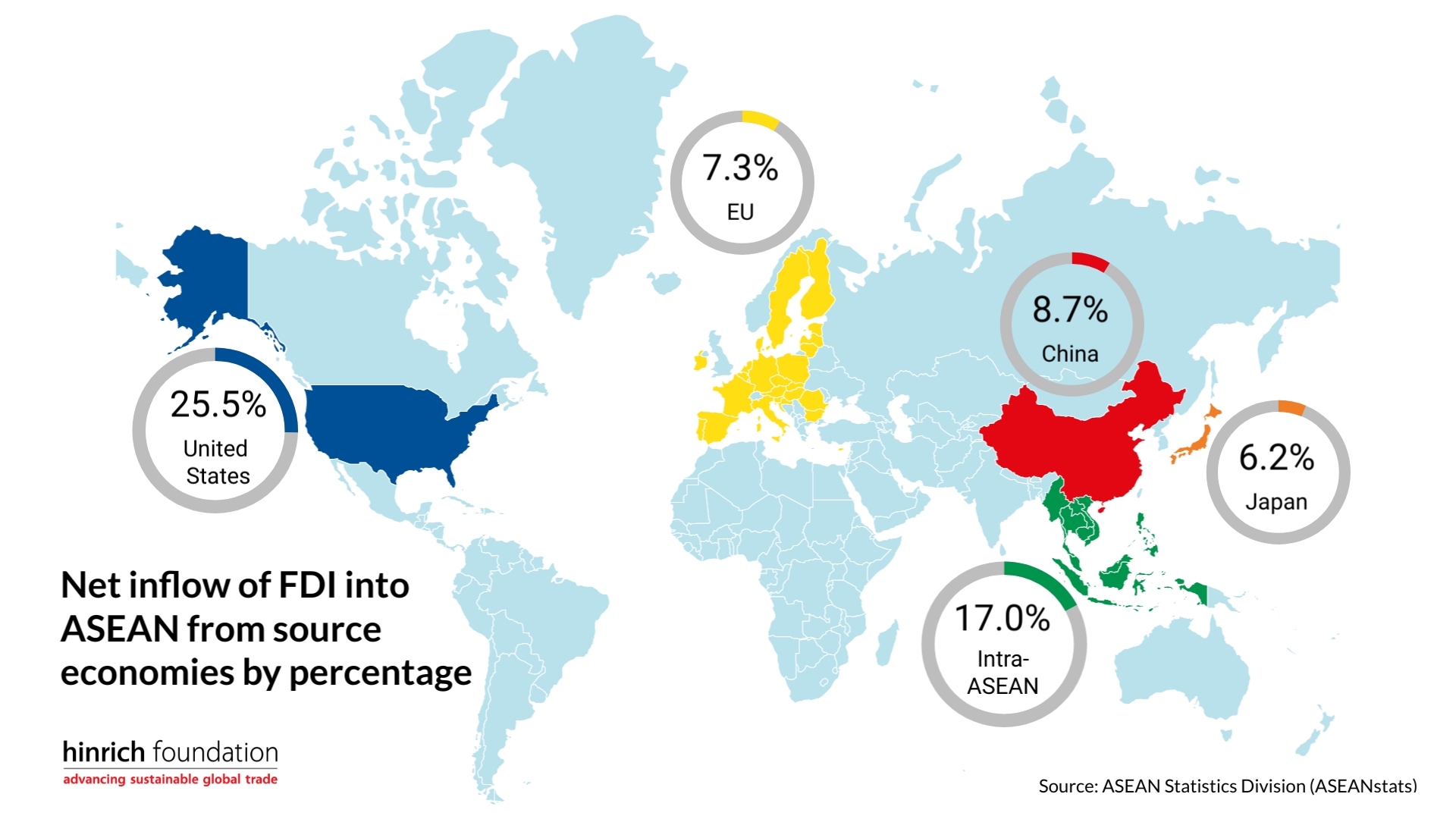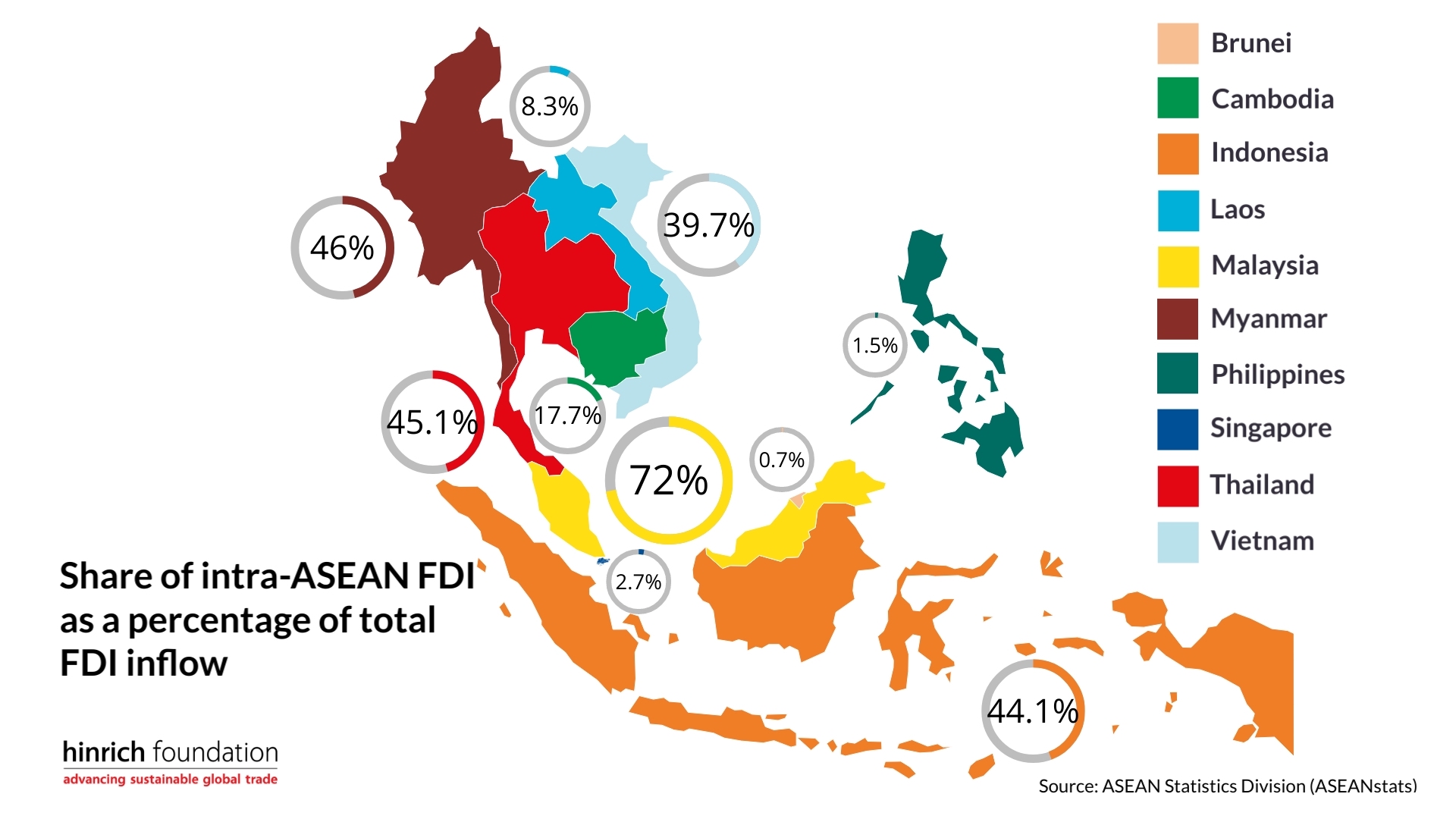Foreign direct investment
Trade and Investment in Southeast Asia
Published 11 April 2023
For decades, the rapid growth of Southeast Asia’s economies has attracted admiration. Today, the world’s fifth largest economy continues to invite foreign investment and eager trading partners. This Hinrich Foundation series on Trade and Investment in Southeast Asia examines the dynamics underpinning economic growth – and asks critical questions about the region’s future.
According to ASEAN, the US was the largest source of FDI inward flows in 2020, accounting for US$34.7 billion or 25.3% of the total FDI inflow into ASEAN states. Meanwhile, intra-ASEAN FDI was recorded at US$23.3 billion, constituting only 17.0% of total ASEAN FDI inflow. Other major sources of FDI to ASEAN were Hongkong-China, the EU, and Japan, with amounts of US$12.0 billion, US$10.5 billion, and US$8.5 billion, respectively.
Data source: ASEAN Statistics Division (ASEANstats)
Intra-ASEAN inward FDI experienced an overall increase of 3.5% from US$22.0 billion in 2019 to US$22.8 billion in 2020. Indonesia, Malaysia, Myanmar, and Thailand each saw over 40% of intra-ASEAN FDI as a share of their total FDI inflows, with Vietnam close behind at 39.7%. The remaining economies of Brunei, Cambodia, Laos, the Philippines, and Singapore saw smaller shares of intra-ASEAN FDI compared to external sources of FDI.
Data source: ASEAN Statistics Division (ASEANstats)
Featured publications:
Enabling sustainable investment in ASEAN
What can ASEAN member states do to further promote investment benefits for their social and environmental objectives? In this report co-sponsored by the Hinrich Foundation, the Organisation for Economic Co-operation and Development (OECD) measures the impact of sustainable FDI in Southeast Asia, reviews the region's investment policy reforms, and suggests ways to enable responsible business conduct and foster green investment.
Supply traceability: How US trade policies affect Vietnam's garment industry
Vietnam’s garment and textile industry has been a vital driver of the country’s economy. While economic integration with the global economy and trade liberalization have created lucrative opportunities for the industry, they have also raised challenges for businesses such as ensuring compliance with fundamental labor rights, including eliminating forced labor. The article examines the impact of the US Uyghur Forced Labor Prevention Act on the garment and textile industry in Vietnam.
Are China's investment projects in Laos a window into the future?
In the last decade, China has invested heavily in building Southeast Asia’s infrastructure. These mega projects loom large for the region’s smaller economies such as Laos, yet account for a fraction of the economic giant’s GDP. This article by Research Fellow Stewart Paterson explains why, for China, that’s a small price to pay for strengthening its orbit of influence.
Can Japan resume a leading role in Malaysia’s industrialization?
For decades, Japanese foreign investment was critical to the industrialization of Malaysia and other countries in Southeast Asia. Read a new paper by Juita Mohamad, Indo-Pacific Fellow at Perth USAsia Centre, which asks a question pertinent to other ASEAN nations: now that Malaysia is pivoting to a digital economy, will Japan resume a large role in the country’s development?
To ease ASEAN’s import dependency, strengthen intra-ASEAN trade
The trade intensity of ASEAN’s ten member states is amongst the highest in the world. But while ASEAN’s gains from trade have been great, can they be improved? This article by Research Fellow Stewart Paterson explores the dynamics of intra-ASEAN trade and ASEAN-China trade.
RCEP and its implications for the Lower Mekong Subregion
The Regional Comprehensive Economic Partnership (RCEP) offers ASEAN members closer engagement with other powers beyond the US and China. How will the world’s largest trade agreement impact the Mekong region nations of Cambodia, Laos, Myanmar, Thailand, and Vietnam? Assistant Professor Kaewkamol Pitakdumrongkit of Singapore’s Nanyang Technological University (NTU) examines the prospects in this article.
© The Hinrich Foundation. See our website Terms and conditions for our copyright and reprint policy. All statements of fact and the views, conclusions and recommendations expressed in this publication are the sole responsibility of the author(s).








